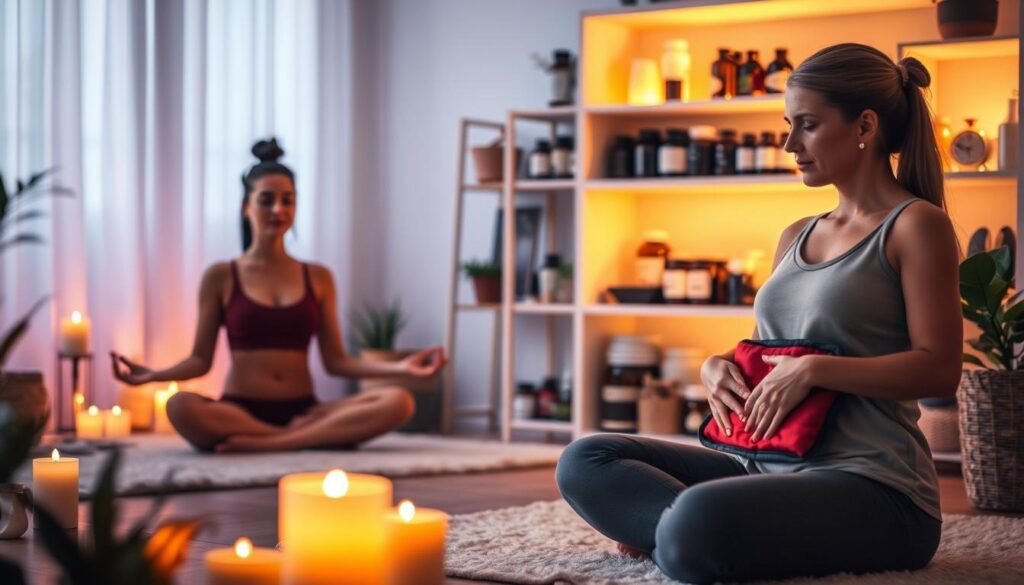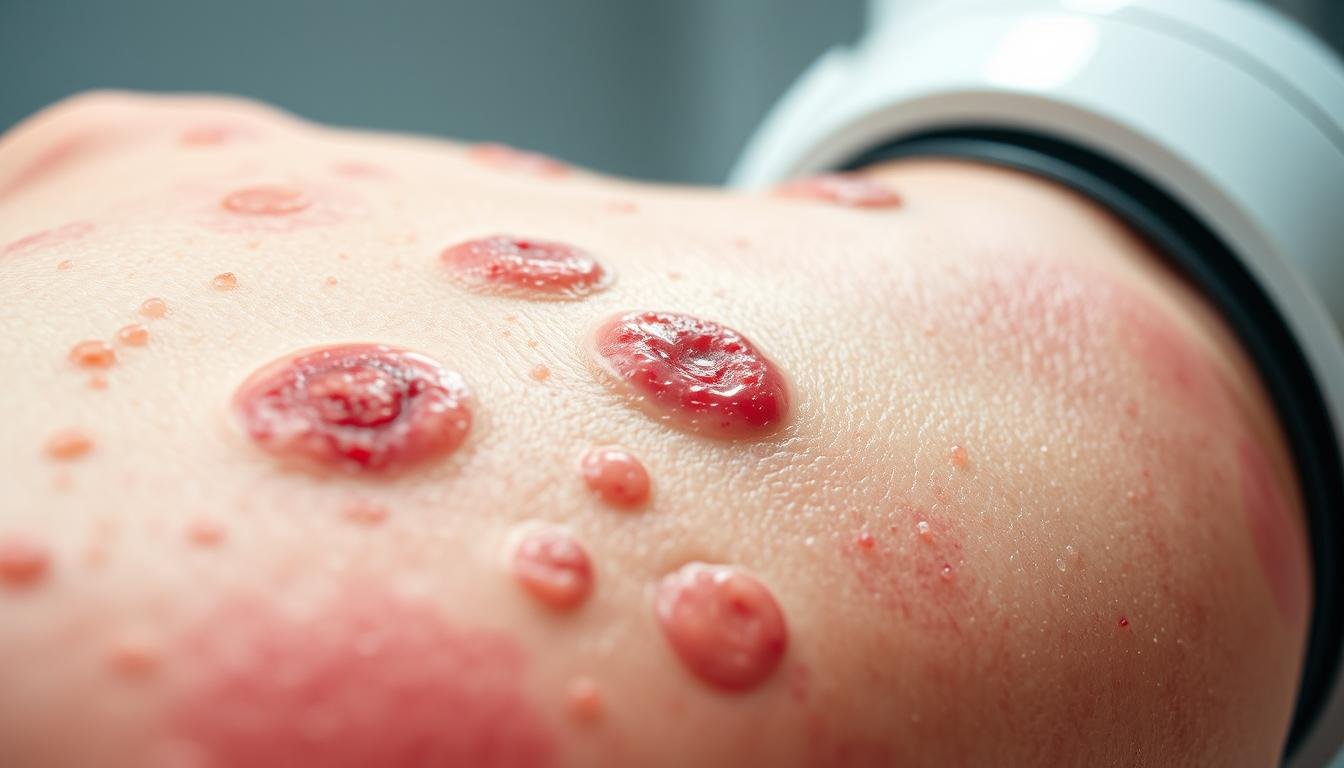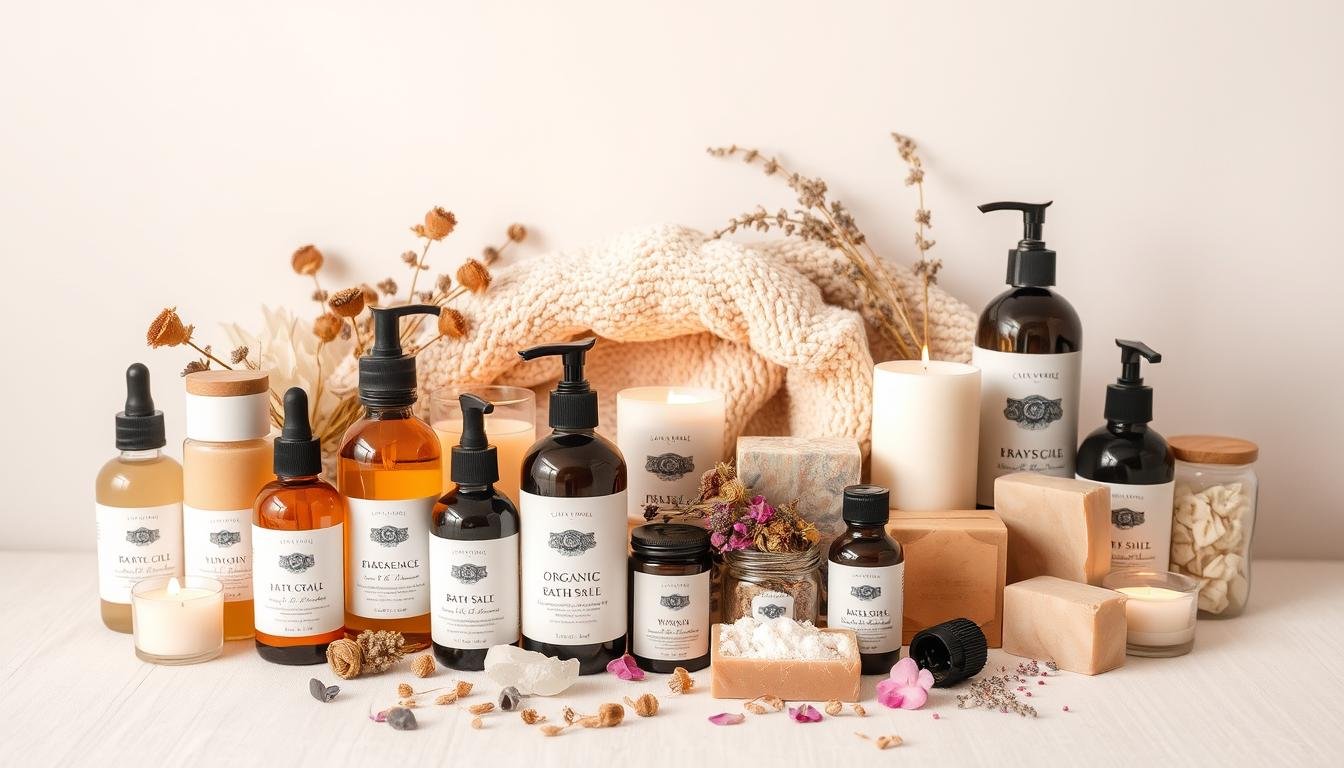Many women face discomfort during their menstrual cycle. Symptoms can range from mild to severe. Holistic approaches to menstrual health offer a way to manage these symptoms.
Prevalence of PMS and menstrual pain is high among women of reproductive age. It affects daily life and overall well-being. Natural remedies can offer relief without the need for drugs.
By focusing on holistic menstrual health, women can manage their symptoms better. This approach can improve their quality of life.
Key Takeaways
- Holistic approaches can help manage menstrual symptoms.
- Natural remedies offer an alternative to pharmaceuticals.
- Focusing on overall well-being can enhance quality of life.
- Understanding the prevalence of PMS can help in seeking appropriate relief.
- Adopting a balanced lifestyle can reduce menstrual discomfort.
Understanding PMS: Symptoms and Causes
Premenstrual syndrome (PMS) affects millions of women worldwide. It causes physical and emotional symptoms that can disrupt daily life. Knowing its causes and symptoms is key to managing it.
Common Symptoms of PMS
PMS symptoms vary but often include mood swings, bloating, and breast tenderness. Fatigue is also common. Some women also face anxiety and depression, which can be hard to handle. Recognizing these symptoms is the first step to managing menstrual pain.
Hormonal Changes During the Menstrual Cycle
Hormonal changes are key in PMS symptoms. The menstrual cycle is controlled by estrogen and progesterone. Changes in these hormones can cause symptoms. For example, the drop in progesterone after ovulation can lead to symptoms in some women.
Lifestyle Factors Influencing PMS
Lifestyle choices like diet, exercise, and stress levels affect PMS symptoms. Eating whole foods and nutrients can help. Regular exercise reduces stress and boosts well-being. Holistic approaches like mindfulness also offer relief.
Understanding PMS symptoms and causes helps women manage it better. This knowledge opens the door to exploring PMS relief supplements and natural remedies.
Natural Remedies for PMS Relief
Natural remedies offer a holistic way to tackle PMS symptoms. They help improve overall well-being. By adding these methods to daily life, women can find relief from PMS discomforts.
Herbal Treatments for PMS
Herbal treatments have been used for centuries to ease PMS symptoms. Chamomile and ginger are great for reducing cramps and promoting relaxation. They can be enjoyed as teas or supplements.
Chamomile tea is known for its calming effects. It helps reduce anxiety and insomnia linked to PMS. Ginger has anti-inflammatory properties that ease menstrual cramps.
Essential Oils for Mood Improvement
Essential oils are a natural way to boost mood and reduce stress. Oils like lavender and clary sage have calming effects that help with PMS symptoms. They can be used in aromatherapy or applied topically after dilution.
Lavender oil is great for promoting relaxation and reducing anxiety. Clary sage helps balance hormones and reduces menstrual cramps.
Dietary Changes to Minimize Symptoms
Making dietary changes can help reduce PMS symptoms. Eating more complex carbohydrates and omega-3 fatty acids can stabilize mood and reduce cramps.
Foods high in complex carbohydrates, like whole grains, boost serotonin levels. This improves mood. Omega-3 fatty acids, found in fish and flaxseeds, have anti-inflammatory effects that reduce menstrual pain.
Exploring these natural remedies helps women manage PMS symptoms. It enhances their overall quality of life.
Diet and Menstrual Health
A balanced diet is key to managing menstrual health and easing PMS symptoms. The right foods can lessen menstrual pain, boost mood, and enhance overall health.
Foods to Include for Better Menstrual Health
Adding specific foods to your diet can ease menstrual symptoms. Leafy greens like spinach and kale are packed with iron. This helps replace iron lost during your period. Fatty fish like salmon are full of omega-3s, which fight inflammation.
- Berries for antioxidants
- Whole grains for fiber
- Nuts and seeds for magnesium and healthy fats
Nutrient Deficiencies to Be Aware Of
Some nutrient gaps can make PMS worse. Knowing these and fixing them through diet or supplements is vital.
| Nutrient | Role in Menstrual Health | Food Sources |
|---|---|---|
| Iron | Replaces iron lost during menstruation | Red meat, spinach, beans |
| Calcium | Supports bone health and muscle relaxation | Dairy, leafy greens, fortified plant-based milk |
| Omega-3 | Reduces inflammation and pain | Fatty fish, flaxseeds, walnuts |
Hydration and Its Role in Relief
Drinking enough water is vital for menstrual health. It helps with bloating, supports detox, and eases cramps and fatigue.
Tips for staying hydrated:
- Drink at least 8-10 glasses of water a day
- Incorporate hydrating foods like watermelon and cucumbers
- Limit caffeine and alcohol, which can dehydrate the body
Mindfulness Practices for Managing Menstrual Pain
Mindfulness practices help manage menstrual pain by focusing on the mind-body connection. They teach us to be aware and accept the present moment. This way, we can handle PMS and menstrual cramps better.
Meditation Techniques for Pain Relief
Meditation is a strong tool against menstrual pain. It includes focused attention and open monitoring meditation. These methods relax us and lower stress, making pain feel less intense.
Simple Meditation Exercise: Sit or lie down in a quiet, comfy spot. Close your eyes and focus on your breath. Say “I am calm” when you inhale and “I release pain” when you exhale.
How Yoga Can Alleviate Symptoms
Yoga combines poses, breathing, and meditation for well-being. It can ease menstrual pain by improving blood flow and relaxing muscles. Poses like the cobra, cat-cow, and child’s pose are great for this.
- Cobra Pose: Strengthens back muscles and opens the chest, improving circulation.
- Cat-Cow Pose: Helps release tension in the spine and pelvis, easing menstrual cramps.
- Child’s Pose: Stretches the back and hips, promoting relaxation.
Breathing Exercises to Reduce Stress
Breathing exercises are great for managing menstrual pain. Deep, controlled breathing lowers stress and relaxes us, easing cramps. The 4-7-8 method and diaphragmatic breathing are especially helpful.
“The way to control the body is through the breath.” – B.K.S. Iyengar
Adding these mindfulness practices to daily life helps manage menstrual pain better. It improves our overall well-being.
The Role of Exercise in Alleviating Menstrual Pain
Adding exercise to your daily routine can help a lot with menstrual pain. It’s known to lessen PMS and menstrual cramp symptoms. This is because exercise releases endorphins, which are natural painkillers.
Recommended Exercises for PMS Relief
Some exercises are better than others for easing menstrual pain. Here are a few:
- Aerobic Exercises: Walking, jogging, and cycling can help by improving blood flow.
- Yoga: Certain yoga poses can ease cramps, boost flexibility, and lower stress.
- Stretching: Gentle stretching can relax the uterine muscles, which helps reduce pain.
How Regular Activity Affects Hormones
Regular exercise can also affect hormone levels, which is key for managing PMS symptoms. It can help regulate menstrual cycles and lessen symptoms by:
- Improving insulin sensitivity
- Reducing prostaglandins, which cause the uterus to contract
- Releasing endorphins, which improve mood and reduce pain
Benefits of Stretching and Relaxation Techniques
Stretching and relaxation methods, like deep breathing and progressive muscle relaxation, can also help. They reduce stress and ease menstrual cramps. These methods help relax muscles and boost overall well-being.
| Technique | Benefits |
|---|---|
| Stretching | Relaxes uterine muscles, reduces pain |
| Deep Breathing | Reduces stress, promotes relaxation |
| Progressive Muscle Relaxation | Relaxes muscle tension, improves well-being |
By adding these exercises and techniques to your routine, you can manage menstrual pain better. This approach reduces the need for PMS relief supplements and other treatments. Exercise is a natural and healthy way to handle menstrual cramps.
Supplements for Holistic Menstrual Health
There are many supplements that can help with PMS and menstrual pain. They can make symptoms better and improve your overall health. This can make life easier for women who deal with menstrual discomfort.
Overview of Vitamin and Mineral Supplements
Vitamins and minerals are key for menstrual health. Calcium and magnesium help relax muscles and ease cramps. If you don’t get enough, you might feel worse.
Here’s a quick guide to vitamins and minerals that help with menstrual health:
| Nutrient | Benefits | Food Sources |
|---|---|---|
| Calcium | Muscle relaxation, cramp relief | Dairy products, leafy greens |
| Magnesium | Relieves cramps, improves mood | Nuts, seeds, whole grains |
| Vitamin B6 | Regulates mood, reduces bloating | Fish, eggs, potatoes |
The Benefits of Omega-3 Fatty Acids
Omega-3 fatty acids, like EPA and DHA, can cut down on inflammation and pain. You can find them in fish oil or eat foods like fatty fish and flaxseeds.

Herbal Supplements That May Help
Some herbal supplements can help with menstrual health. Ginger has anti-inflammatory properties that can lessen pain. Turmeric has curcumin, which is very good at fighting inflammation.
Black cohosh and red clover are also used. They’re thought to balance hormones and ease PMS symptoms.
The Importance of Sleep for Menstrual Well-being
Sleep is key for hormonal balance, which affects menstrual health. It’s important for the body’s processes, including menstrual health. Sleep helps the body repair and balance hormones for a healthy cycle.
Influencing Hormonal Balance
Sleep deeply affects hormonal balance. The body’s hormonal system is complex. Sleep issues can cause imbalances that harm menstrual health.
Sleep helps keep estrogen and progesterone in balance. These hormones are vital for the menstrual cycle. Getting enough sleep can lessen menstrual symptoms.
Key Hormones Affected by Sleep:
- Estrogen
- Progesterone
- Cortisol (stress hormone)
Improving Sleep Quality
Good sleep is vital for menstrual health. To improve sleep, stick to a schedule, have a calming bedtime routine, and avoid caffeine and screens before bed. A dark, quiet room and a comfy mattress also help.
Tips for Better Sleep:
- Establish a bedtime routine
- Avoid screens before bed
- Keep the bedroom cool and dark
- Invest in a comfortable mattress
The Connection Between Stress and Sleep
Stress and sleep are linked. Stress can ruin sleep, and bad sleep can make stress worse. This cycle worsens menstrual symptoms. Managing stress is key to better sleep and less pain.
“Stress management is crucial for improving sleep quality, which in turn can help alleviate menstrual symptoms.” – Expert in Women’s Health
By focusing on sleep and using strategies to improve it, women can manage menstrual pain better. It’s about a holistic approach that includes natural remedies, lifestyle changes, and stress management.
Acupuncture and Its Benefits for Menstrual Pain
Acupuncture is becoming more popular for natural PMS relief. It’s an ancient Chinese medicine that uses thin needles to help the body heal itself.
What to Expect During an Acupuncture Session
At an acupuncture session for menstrual pain, a practitioner will first check your health and symptoms. You’ll lie on a table, and they’ll put fine needles in certain points. These points are on your abdomen, lower back, and legs, near your reproductive system.
“Acupuncture has been a game-changer for my menstrual cramps,” says Sarah, a 30-year-old marketing executive. “I’ve tried various remedies, but the combination of acupuncture with other holistic approaches has significantly reduced my pain.”
Evidence Supporting Acupuncture’s Effectiveness
Studies show acupuncture can help with menstrual pain. A Journal of Pain Research study found it lessened menstrual cramps. It’s thought acupuncture releases endorphins and improves blood flow.
- Reduces severity of menstrual cramps
- May decrease the need for pain medication
- Can improve overall well-being
Finding a Qualified Acupuncturist
To find a good acupuncturist, look for licensed ones with experience in menstrual pain. Check the National Certification Commission for Acupuncture and Oriental Medicine (NCCAOM) for certified practitioners. Reading reviews and asking for referrals can also help.
Adding acupuncture to your PMS relief plan can help a lot. Always talk to a healthcare provider to find the best treatment for you.
The Power of Heat Therapy
Applying heat is a simple yet effective way to ease menstrual cramps. Heat therapy relaxes the uterine muscles and improves blood flow. This makes it a popular choice for menstrual pain relief.
Benefits of Heating Pads and Warm Baths
Heating pads and warm baths are common heat therapy methods. Heating pads apply direct heat to the lower abdomen. This helps relax the uterine muscles and reduce cramping.
Warm baths offer overall relaxation. They reduce stress and promote well-being. A warm bath before bed can also improve sleep quality during the menstrual cycle.
Soaking in a warm bath for at least 20 minutes can significantly reduce menstrual discomfort.
How Heat Affects Muscle Relaxation
Heat therapy increases blood flow to the affected area. This helps relax muscles and reduce pain. When heat is applied to the lower abdomen, blood vessels dilate.
This allows more blood to flow to the area. Increased blood flow reduces muscle spasms and cramping associated with menstrual pain.
When to Use Heat for Maximum Relief
For maximum relief, use heat therapy as needed throughout the day. It’s most effective at the onset of menstrual cramps. Consistency is key.
Using heat therapy regularly during the menstrual cycle can provide significant relief from menstrual pain.
| Method | Benefits | Tips for Use |
|---|---|---|
| Heating Pads | Direct heat to the lower abdomen, relaxes uterine muscles | Use on low to medium heat setting, avoid falling asleep with it on |
| Warm Baths | Overall relaxation, reduces stress, improves sleep | Soak for at least 20 minutes, add calming essential oils like lavender |
Building a Supportive Community
Creating a network of support is key for better menstrual health and natural PMS relief. A supportive community offers emotional support, shares experiences, and gives practical advice. This helps manage menstrual health better.
The Importance of Open Conversations
Talking openly about menstrual health helps break down stigmas. It allows women to share their stories and learn from others. This builds a sense of community and support.
Open discussions about menstrual health lead to better understanding and empathy.
Support Groups and Resources Available
Many support groups and resources are out there for women dealing with menstrual health. You can find local groups, online forums, and educational materials from healthcare professionals.
| Resource Type | Description | Benefits |
|---|---|---|
| Local Support Groups | Face-to-face meetings for sharing experiences | Emotional support, practical advice |
| Online Forums | Virtual spaces for discussion and advice | Accessibility, anonymity, diverse perspectives |
| Educational Resources | Information provided by healthcare professionals | Accurate information, guidance on treatments |
Online Forums and Social Media Support
Online forums and social media are crucial for women seeking support and info on menstrual health. They offer a space to connect, share stories, and find solidarity.
Social media campaigns also help raise awareness about menstrual health and holistic PMS management.
By using these resources and encouraging open talks, women can create a supportive community. This community boosts overall well-being and helps manage menstrual health more effectively.
Exploring Traditional Herbal Remedies
Many women are turning to traditional herbal remedies for menstrual health. These natural treatments have been used for centuries. They help with PMS and menstrual pain symptoms.
Popular Herbs with Historical Use
Several herbs are known for easing menstrual discomfort. Some of the most notable include:
- Ginger: Known for its anti-inflammatory properties, ginger has been used to reduce pain and discomfort.
- Chamomile: This herb is often used to calm menstrual cramps and promote relaxation.
- Raspberry Leaf: Rich in nutrients, raspberry leaf tea is believed to help tone the uterus and ease menstrual symptoms.
Safety Considerations and Side Effects
Herbal remedies can be effective but need careful consideration. Some herbs can interact with medications or have adverse effects when taken in large quantities.
| Herb | Potential Side Effects | Precautions |
|---|---|---|
| Ginger | Heartburn, stomach upset | Avoid excessive consumption, especially if you have a bleeding disorder. |
| Chamomile | Drowsiness, allergic reactions | Use with caution if you’re allergic to ragweed or take blood thinners. |
| Raspberry Leaf | None noted, but may cause uterine contractions | Consult a healthcare provider before using during pregnancy. |
How to Safely Source Herbal Treatments
To ensure safe use of herbal remedies, source them from reputable suppliers. Look for products that are certified organic and have been tested for purity.
Understanding the benefits and risks of traditional herbal remedies helps women make informed decisions. Always consult with a healthcare provider before starting any new treatment.
When to Seek Professional Help for PMS
Knowing when to get help for PMS is key. Many women find relief with natural methods. But, some symptoms are too severe and need a doctor’s care.

Signs That Indicate You Should Consult a Doctor
Severe PMS symptoms can really disrupt your life. If you’re dealing with any of these, it’s time to see a doctor:
- Severe cramps that don’t go away with over-the-counter meds
- Heavy bleeding that makes it hard to do everyday things
- Feeling really down or anxious
- Severe bloating and stomach problems
Seeing a doctor can open up more treatment options. They can help you manage your symptoms better.
Understanding Hormonal Imbalances
Hormonal changes are a big part of PMS. Knowing about these changes helps find the right treatment. Hormones like estrogen and progesterone are key in the menstrual cycle. Imbalances can cause many symptoms.
Finding out what hormonal issues you have is important for managing PMS. Doctors might run tests to check hormone levels.
Possible Medical Treatments and Interventions
Doctors may suggest different treatments based on your symptoms. These can include:
- Hormonal therapies to balance hormones
- Prescription meds for serious symptoms
- PMS relief supplements that have scientific backing
These treatments can work with natural methods for better care. It’s important to talk about the benefits and risks with your doctor.
By knowing when to get professional help, women can better manage their PMS. This improves their overall health and well-being.
Creating a Personalized Holistic Health Plan
Creating a personalized health plan can greatly help with menstrual pain. By taking a proactive and tailored approach, you can manage your symptoms better. This improves your overall well-being.
Steps to Identify Effective Remedies
To make an effective plan, start by finding what works for you. Look into natural PMS relief options like diet changes, herbal treatments, and mindfulness.
- Keep a symptom journal to track your experiences.
- Research and list potential remedies that align with your symptoms.
- Gradually introduce new remedies into your routine.
Tracking Your Symptoms and Responses
It’s important to monitor your symptoms and how different remedies affect you. This helps you see what works and what doesn’t. You can then adjust your plan accordingly.
Use a symptom tracker to record your experiences. Note the severity of your symptoms and any changes to your routine. This will help you spot patterns and connections.
| Symptom | Remedy Tried | Response |
|---|---|---|
| Cramps | Heat Therapy | Significant Relief |
| Mood Swings | Omega-3 Supplements | Moderate Improvement |
Adjusting Your Plan as Needed
As you learn more about your symptoms and how remedies affect you, be ready to make changes. This might mean adjusting your diet, changing your exercise routine, or trying different menstrual pain remedies.
Stay open to new ideas. Your holistic health plan should grow with you. This ensures you keep getting the best relief from PMS symptoms.
Myths and Misconceptions About PMS
Many myths surround PMS, and it’s time to clear up the confusion. Premenstrual syndrome affects women differently, yet it’s often misunderstood.
Common Misunderstandings Debunked
One myth is that PMS is just a minor issue. But for many, it can really disrupt daily life, causing symptoms from mild to severe. Another myth is that PMS is only about hormonal changes, ignoring lifestyle and environmental factors.
Some common myths include:
- PMS is just an excuse for being moody or irritable.
- All women experience PMS in the same way.
- PMS is not a “real” medical condition.
These myths can harm women who deal with PMS. By knowing the truth, we can help change these myths and offer better support.
The Impact of Stigma on Women’s Health
The stigma around PMS can deeply affect women’s health. When PMS is not taken seriously, women might feel too ashamed to talk about their symptoms. This can lead to delayed diagnosis and treatment.
“The stigma associated with PMS can prevent women from seeking help and discussing their symptoms openly, which is crucial for effective management.”
A study on stigma and menstrual health found that:
| Aspect | Effect of Stigma | Potential Solution |
|---|---|---|
| Symptom Discussion | Women are less likely to discuss symptoms openly. | Normalize conversations about PMS. |
| Seeking Help | Stigma can delay women from seeking medical help. | Educate healthcare providers about PMS. |
| Support Systems | Lack of support from family and friends due to stigma. | Raise awareness about PMS among the general public. |
Educating Others About Menstrual Health
Education is crucial to fight PMS stigma. By learning and sharing about menstrual health, we can create a more supportive space for women.
Ways to promote education include:
- Sharing accurate information about PMS and its effects.
- Encouraging open conversations about menstrual health.
- Supporting initiatives that aim to improve menstrual health education.
Together, we can build a community that understands and supports women with PMS.
Conclusion: Embracing Holistic Approaches for Menstrual Health
Throughout this guide, we’ve seen how holistic PMS relief strategies can help manage menstrual pain. They improve overall well-being too. By understanding PMS causes and using natural remedies, women can manage their menstrual health better.
Key Strategies for Relief
Effective ways to manage menstrual pain include changing your diet, practicing mindfulness, and using herbal supplements. These natural methods can be adjusted to fit each person’s needs. This makes health care more personal.
Empowering Women’s Health
Exploring holistic approaches helps women go beyond just treating symptoms. They learn more about their bodies. This knowledge lets them make better health choices, leading to better overall health.
Moving Forward
Women should keep looking for new ways to improve their menstrual health. By trying different strategies, they can fully benefit from holistic PMS relief. This leads to a better quality of life.



